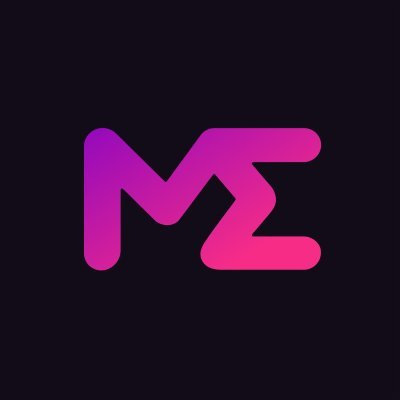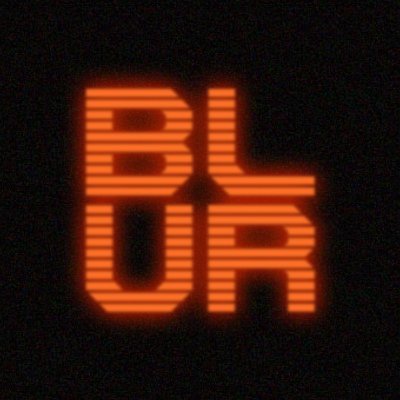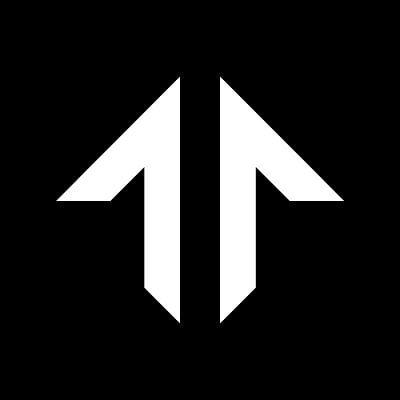Galaxy: The NFT Competition Between Solana and Ethereum
Title: "Solana Leads NFT Market Recovery, Ethereum NFT Market Poised to Follow in 2024"
Author: Gabe Parker, Galaxy Research
Compiled by: Luccy, BlockBeats
Editor's Note:
As the crypto market continues to evolve, Solana and Ethereum are engaged in a fierce competition as the leading NFT ecosystems. Galaxy Research analyst Gabe Parker provides a detailed analysis of the performance of Solana and Ethereum NFTs in 2023, highlighting the rapid recovery of NFT trading activity on Solana and the challenges faced by Ethereum.
Gabe Parker notes that, driven by Blur and Tensor, Solana's NFT market has excelled in terms of active users and trading volume. While Ethereum still dominates the market, it faces the challenge of declining active NFT users. As the NFT market evolves, the competition between Solana and Ethereum is expected to intensify in 2024.
Key Points
- NFT trading activity on Solana has recovered 2.6 times faster than on Ethereum.
- In 2023, Ethereum contributed over 90% of weekly NFT trading volume for 67% of the time.
- As of January 8, 2024, Solana's weekly NFT trading volume accounted for 25% of total NFT trading volume.
- In 2023, the number of active NFT users on Ethereum decreased by 73%, while Solana's active NFT users increased by over 80%. NFT users are identified as unique addresses that mint, buy, sell, or transfer NFTs within a day.
- With the growing popularity of the advanced NFT trading platform Blur, there has been a significant shift in NFT market concentration in 2023. Unlike existing players like OpenSea, Blur heavily relies on incentive programs such as token airdrops to attract users.
- In 2023, Blur accounted for 67% of Ethereum's total NFT trading volume. Before Blur's launch, OpenSea held over 80% of NFT trading volume, but only accounted for 29% of Ethereum's total NFT trading volume that year.
Introduction
In the fourth quarter of 2023, the NFT market saw a meaningful recovery. As of January 16, 2024, Ethereum's NFT trading volume has quadrupled since its respective low in 2023, while Solana's NFT trading volume has increased by over ten times. As NFT trading volume recovers from historical lows, the floor prices of top NFT projects on both Ethereum and Solana are rising. This research report will focus on the recovery of NFTs in the Solana and Ethereum ecosystems and provide insights into their growth in 2024. The report will also analyze the characteristics of incentive-driven NFT markets like Blur and Tensor, which have been consolidating significant market share from existing NFT markets like OpenSea.
Ethereum NFT Market
Ethereum's NFT trading volume hit a low in September 2023, reaching a monthly low of $143 million. The week from October 9 to October 16, 2023, was particularly challenging, with Ethereum NFT trading volume plummeting to just $40 million. However, a significant turnaround occurred after October 9, 2023, with Ethereum NFT weekly trading volume astonishingly surging by 380%. This sharp increase was primarily due to the Blur Season 2 airdrop that took place on November 20, 2023. Blur incentivizes NFT bidding, listing, and lending on its platform through the $BLUR token. Notably, NFT traders were actively engaging in trading weeks before such airdrops, as evidenced by similar trends during the Blur Season 1 airdrop on February 14, 2023. Additionally, the consequences of the airdrop triggered a wealth effect, prompting NFT traders to reinvest their airdrop funds into NFTs to maintain their points farming.

Despite Ethereum's weekly NFT trading volume increasing by 380% from its 2023 low, it still represents an 89% decline compared to the historical high in March 2022. The Ethereum NFT market has a long way to go in its recovery. As we enter 2024, the next cycle of the Ethereum NFT ecosystem may be driven by advanced NFT trading platforms (such as Blur and Blast) incentivizing trading activity through airdrops.
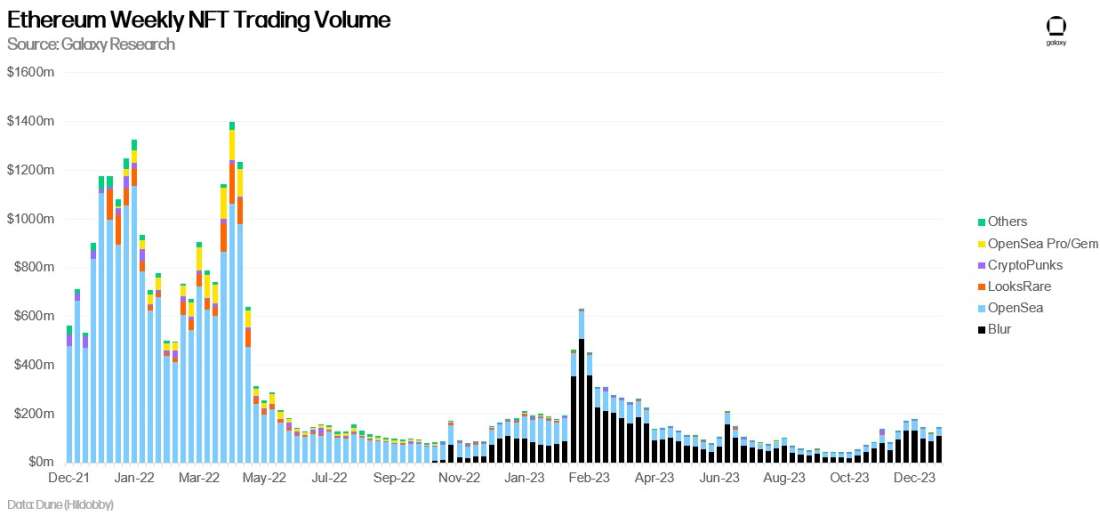
OpenSea launched its professional trading platform in April 2023 to compete with Blur; however, since September 2023, OpenSea Pro has only accounted for 9% of Ethereum NFT trading volume. Blur continues to dominate professional NFT trading, primarily due to its first-mover advantage and UX/UI design. For example, Blur's utilization of an order book system allows NFT traders to better assess the depth of floor prices than any other market. Combined with Blur's native NFT lending platform Blend, it provides NFT traders with tools to build complex trading strategies.
Looking ahead to 2024, Blur's position is solidified by the upcoming Season 3 airdrop planned for May 2024. This event is expected to further incentivize NFT traders who have previously used Blur, as 50% of the next airdrop will be allocated to existing $BLUR token holders. Blur's strategic advantages extend beyond its first-mover status to the comprehensive ecosystem it has developed.
Blur's proactive stance on token economics is reflected in its recent governance proposal. The proposal advocates for community activation of fee conversion, charging a 1% market fee on funds generated for purchases, which is intended for the buyback and burn of $BLUR tokens, thereby reducing the supply of $BLUR. Although this governance proposal is currently pending, it demonstrates Blur's continued focus on refining platform token economics to position itself as a significant player in the evolving NFT market landscape.
While the recent surge in NFT trading volume is attributed to the re-engagement of crypto-native users in NFT markets like Blur, a significant number of NFT traders remain on the sidelines. Notably, the number of weekly traders on OpenSea has decreased by 86% from the historical high in January 2022, indicating that many retail users have yet to re-enter the market. Although Blur is the most favored NFT market in the cryptocurrency community, it primarily caters to a more mature and affluent group of NFT traders. In this context, monitoring OpenSea's trading volume share is crucial for gauging the revival of retail interest in NFTs.
Solana NFT Market
Solana's NFT trading volume also hit a low in September 2023, reaching $30 million. The week from October 9 to October 16, 2023, marked the worst week for Solana NFT trading, generating only $4.3 million in trading volume. Since October 16, 2023, Solana's weekly NFT trading volume has increased by over ten times. The significant growth in Solana NFT weekly trading volume can be attributed to two main factors:
- The announcement of an upcoming airdrop for Solana's advanced NFT trading platform Tensor.
- A substantial repricing and additional attention to all Solana NFTs due to the significant increase in the SOL token.
Tensor, launched in 2022, is Solana's version of Blur, where NFT traders can formulate complex trading strategies. The second season airdrop for Tensor concluded in August 2023, with the next airdrop expected sometime in January 2024, prompting Solana NFT collectors to increase trading activity for farming points. A more critical influence driving the Solana NFT ecosystem is the wealth effect experienced by Solana holders. With SOL rising 615% throughout 2023 and generous airdrops distributed to the community from various Solana applications, activity across various types of Solana applications (including NFTs) is increasing.
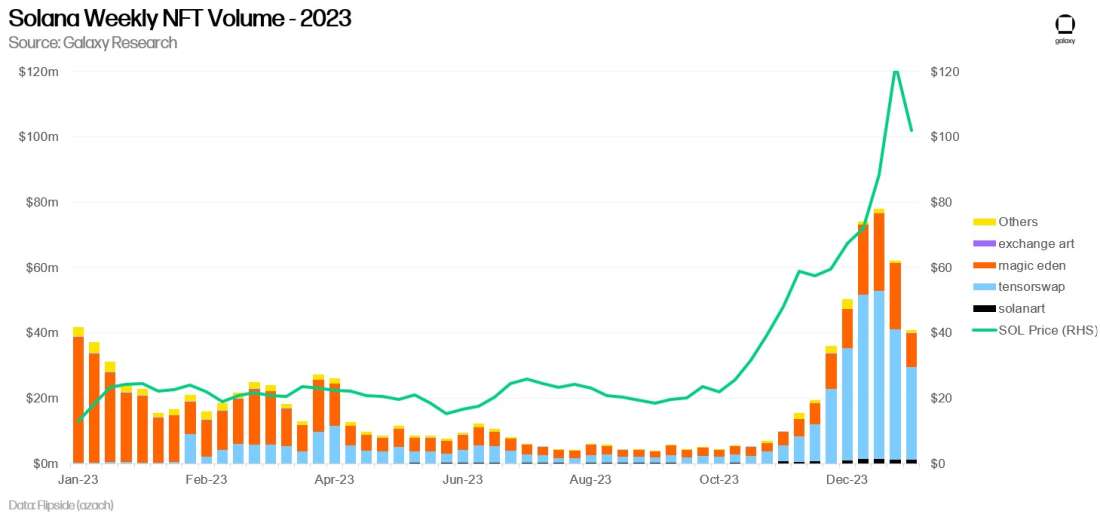
Although Solana's NFT ecosystem is recovering faster than Ethereum's, weekly Solana NFT trading volume is still down over 60% from the historical high in May 2022. Like Ethereum, Solana has a robust NFT ecosystem that offers users an economical and user-friendly experience for trading NFTs. Additionally, Solana's NFT infrastructure is rapidly maturing, as wallets and other NFT applications incorporate features such as displaying NFTs alongside fungible tokens to better support the growth of the digital collectibles ecosystem. Overall, Solana's next NFT market cycle, like Ethereum's, may be driven by trading activity on advanced trading platforms like Tensor.
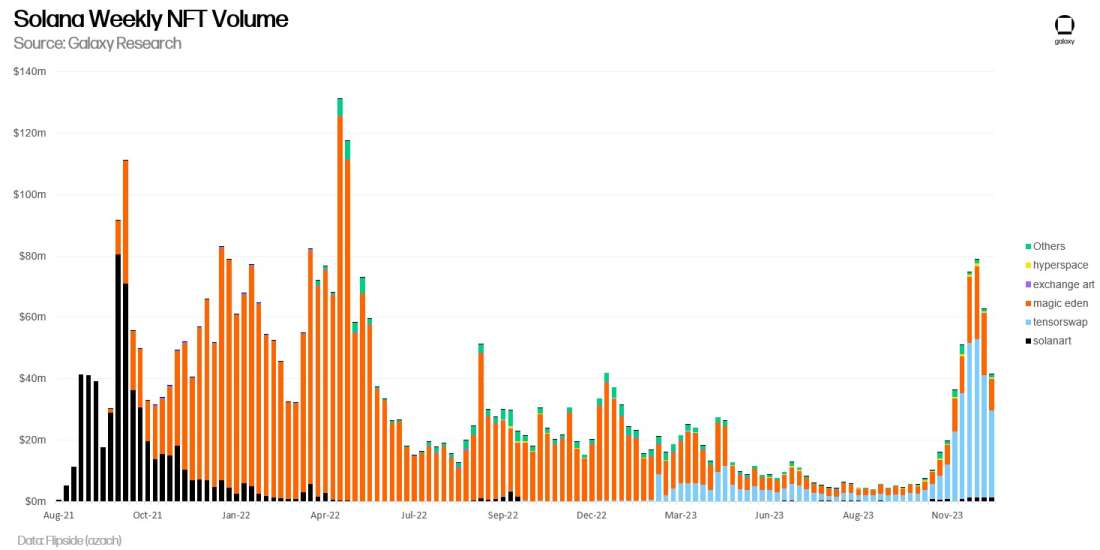
Market Concentration
Advanced trading platforms like Blur and Tensor have rapidly developed and captured a significant portion of NFT trading volume on their respective chains. The concentration of the NFT market is a mutually beneficial result for active NFT traders, who rely on ample liquidity to enter and exit highly volatile assets. Blur and Tensor incentivize users to provide liquidity to their markets through reward airdrops, allowing sellers to gauge the market depth of a given NFT through airdrops. Before Blur and Tensor, traditional NFT markets like OpenSea utilized a bidding system without incentives. The lack of motivation for buyers to submit competitive bids led to dispersed bids that were significantly below the asking price of NFTs.
In 2023, Blur accounted for 67% of Ethereum's total NFT trading volume. Before Blur's launch, OpenSea held over 80% of NFT trading volume, but now only accounts for 29% of Ethereum's total NFT trading volume.
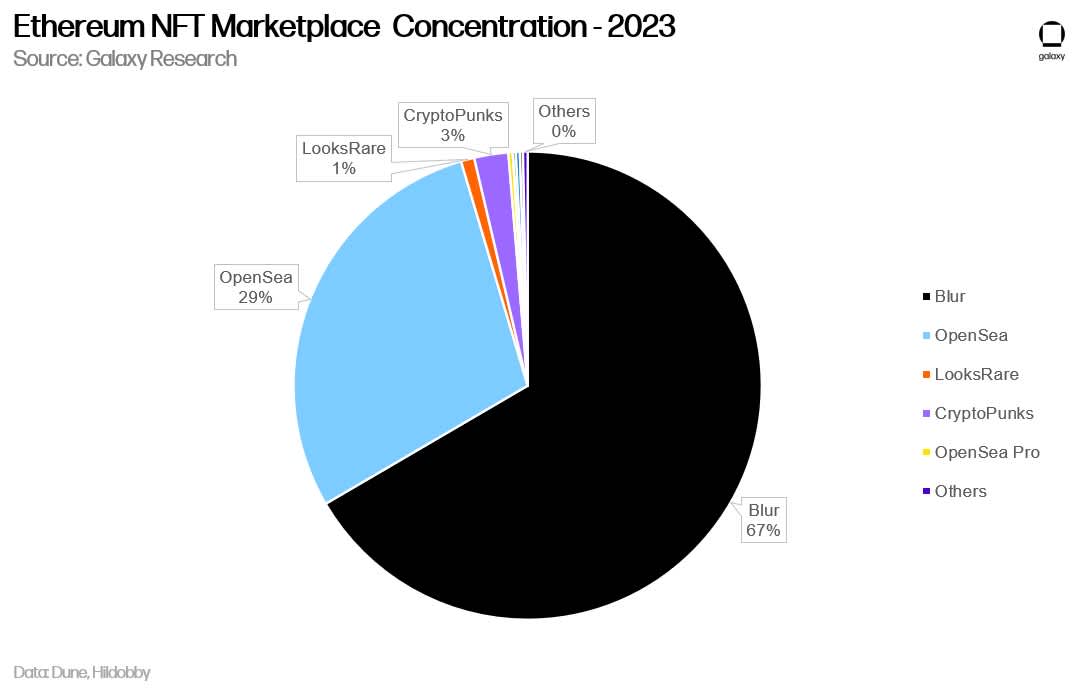
In 2023, Magic Eden dominated the Solana NFT trading space, capturing 51% of total trading volume, which is impressive. However, Tensor secured a solid second place, accounting for 41% of Solana NFT trading volume that year.

Although Magic Eden led Tensor in 2023, there were several days when Tensor's trading volume surpassed Magic Eden's, particularly during the NFT market recovery in October 2023. From October 1, 2023, to January 1, 2024, Tensor significantly surged ahead, with trading volume exceeding Magic Eden's by 50%.

As advanced trading platforms prepare for the third season airdrop and other incentive-driven programs to attract liquidity, Tensor is expected to surpass Magic Eden's market share in the NFT market in 2024.
The impact of Blur and Tensor on NFT market concentration indicates that advanced trading platforms are seeking a clear product-market fit. Although Blur and Tensor were launched during a bear market, these platforms have successfully captured market share from established traditional markets like OpenSea and Magic Eden.
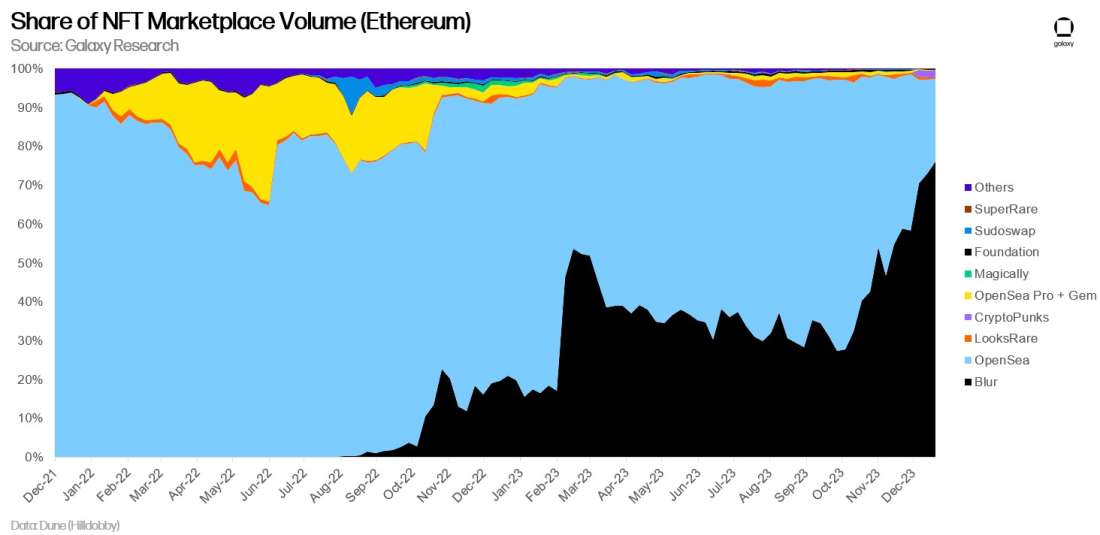
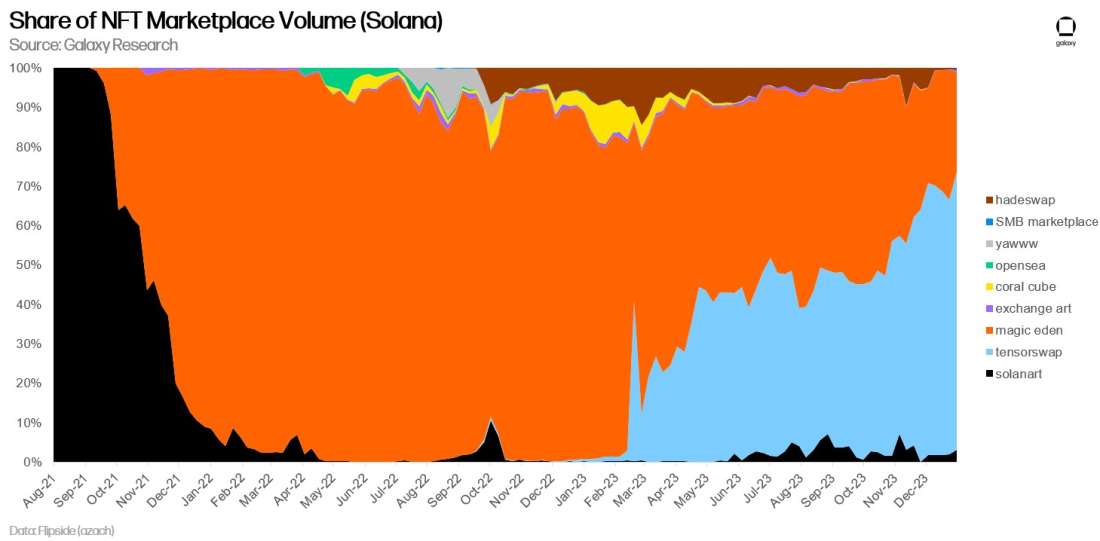
Ethereum vs Solana: Weekly NFT Trading Volume and Active Users
In 2023, Ethereum dominated the NFT space, accounting for over 90% of the weekly NFT trading volume throughout the year. This metric excludes trading volume from Ordinals and BRC-20 on Bitcoin. Notably, Ordinals and BRC-20 generated $1.8 billion in trading volume in 2023, making Bitcoin the second most popular digital collectibles network during this period. This report focuses solely on the NFT markets of Solana and Ethereum; for more information on Ordinals, please refer to this Galaxy Research report.
From May 2023 to September 2023, Solana NFTs faced fierce competition for market dominance against Ethereum NFTs. During this period, Solana NFTs accounted for less than 10% of total NFT trading volume (including both Ethereum and Solana NFT trading volume). However, Solana NFTs finally made significant strides in November 2023 and quickly gained market share in NFT trading volume thereafter. In December 2023, Solana NFTs accounted for at least 22% to 37% of total NFT trading volume weekly.

In 2024, Solana NFT trading volume will continue to compete with Ethereum's NFT trading volume. Since December 1, 2023, $50.5 million has been bridged from other blockchains such as Avalanche, BNB Smart Chain, Arbitrum, and Ethereum to Solana. Although the influx of new capital into Solana may be driven by airdrops and yields provided by Solana decentralized finance (DeFi) applications, which can exit immediately after entering the ecosystem if incentives change, we can expect some of the new capital to flow into Solana NFTs. Depending on the speed of Ethereum NFT recovery and the amount of new capital flowing into Solana as of December 2023, Solana NFT trading volume could reach 30%-50% of total NFT trading volume in 2024.
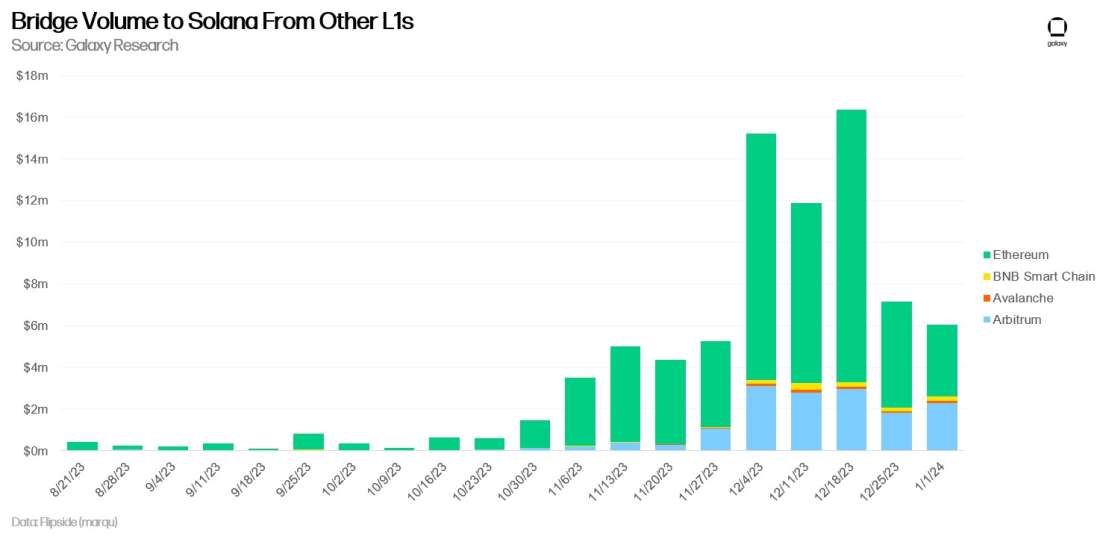
By observing the on-chain activity of wallets that purchase, sell, or mint NFTs in a single day, it is evident that the Ethereum NFT market lacks new users. In 2023, the number of active NFT users on Ethereum decreased by 73%, while Solana's NFT active users increased by over 200% during the same period. The number of active NFT users on Solana surged on December 19, 2023, surpassing the number of active NFT users on Ethereum. Applying a 30-day moving average to the active NFT user counts on Ethereum and Solana, we can see that Solana now has more daily active NFT users than Ethereum.

It is important to note that active NFT users in the data above are identified as unique addresses that mint, buy, sell, or transfer NFTs within a day. A unique address may be owned by a single individual or entity, and the number on Solana may be larger due to lower transaction costs compared to Ethereum.
Conclusion
The upcoming NFT cycle will be driven by advanced NFT trading platforms, novel airdrop incentives for NFT holders, and the wealth effect brought about by a broader recovery in the crypto market. Advanced NFT trading platforms have already solidified their positions in the market, and as liquidity integrates into these types of platforms, their market dominance will continue to range between 50%-60%. Overall, as Solana's NFT ecosystem experiences its first repricing moment, one of the most noteworthy developments in 2024 will be the repricing of Ethereum NFTs if the price of ETH also rises significantly.






